| کد مقاله | کد نشریه | سال انتشار | مقاله انگلیسی | نسخه تمام متن |
|---|---|---|---|---|
| 4574143 | 1629506 | 2011 | 5 صفحه PDF | دانلود رایگان |

Montmorillonite could be a kind of potential low cost sorbent for various kinds of heavy metals since it is abundant in nature and only needs little processing. Humic acid modified Ca-montmorillonite was prepared so as to adsorb copper (II) (Cu2+), cadmium (II) (Cd2+) and Chromium (III) (Cr3+) ions from aqueous solutions. The obtained materials were characterized by powder X-ray diffraction (XRD) and Fourier transform infrared (FTIR) spectroscopy. Then, batch experiments were carried out to investigate the possible adsorption mechanisms of the metal ions on humic acid modified Ca-montmorillonite. The results showed that the adsorption capacities of the modified clay for the metal ions were improved significantly as compared to that of the raw clay. The maximum adsorption capacities followed the order of Cr3+ > Cu2+ > Cd2+ for both materials. Furthermore, the adsorption equilibrium data of Cu2+, Cd2+ and Cr3+ by humic acid modified clay showed that the Langmuir model provided better correlation of the equilibrium data than the Freundlich model, as well as for the adsorption of Cu2+ and Cd2+ by the raw clay. However, Cr3+ adsorption isotherm of the raw clay was better represented by the Langmuir model, indicating that the adsorption mechanisms of the trivalent metal ion on humic acid modified Ca-montmorillonite was quite different from that of the raw Ca-montmorillonite. Finally, the adsorption kinetics was evaluated utilizing the Pseudo-first-order, Pseudo-second-order and Elovich equations, respectively. The results showed that the adsorption kinetic data fit well by the Pseudo-second-order equation for all studied systems, suggesting that the adsorption rate depended on the number of ions on the adsorbent surface.
► The montmorillonite modified with humic acid was prepared.
► The modified clay was applied to adsorb heavy metals.
► The main adsorption mechanism was ion exchange.
► The trivalent ion adsorption mechanism was different than the divalent ions.
Journal: Geoderma - Volume 164, Issues 3–4, 15 September 2011, Pages 215–219